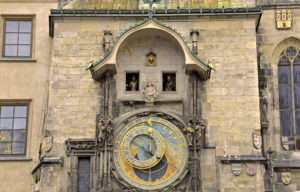
The Orloj on Prague’s Old Town Hall (Photo by Don Knebel)
The heart of the Orloj was constructed in1410 on the southern wall of Prague’s Old Town Hall by a clockmaker and a Prague astronomy professor. A golden hand at the end of a moving arm points to Roman numerals marking the hours since midnight, the current method of reporting the time. The hand also points to Schwabacher numerals on a rotating ring showing Bohemian time, measured in hours since sunset. A sun moving along the arm crosses lines with Arabic numerals showing the Planetary Hours since sunrise, a variable unit always measuring twelve hours from sunrise to sunset. The position of the sun along the arm marks the time of sunrise and sunset. The intersection of the sun with a rotating dial determines the Zodiac sign. A star on another moving arm shows sidereal time, taking into account the earth’s changing position relative to the stars. A third arm shows the position of the moon, represented by a rotating sphere displaying the moon’s current phase.
Animated figures have been added to the Orloj since 1410 to celebrate the hours. As a skeleton representing Death strikes each hour in the march of time, figures representing Vanity, Greed and Frivolity shake their heads. Above them, Twelve Apostles march behind two opened doors until a golden rooster crows to signal the end of the hour’s pageantry.
Each hour between 9:00 am and 9:00 pm (on the Roman numerals), hundreds of visitors enjoy the actions of the Orloj’s figures and then walk on, few appreciating the ingenuity behind its timekeeping mechanisms, devised when even astronomers believed the sun traveled around the earth.